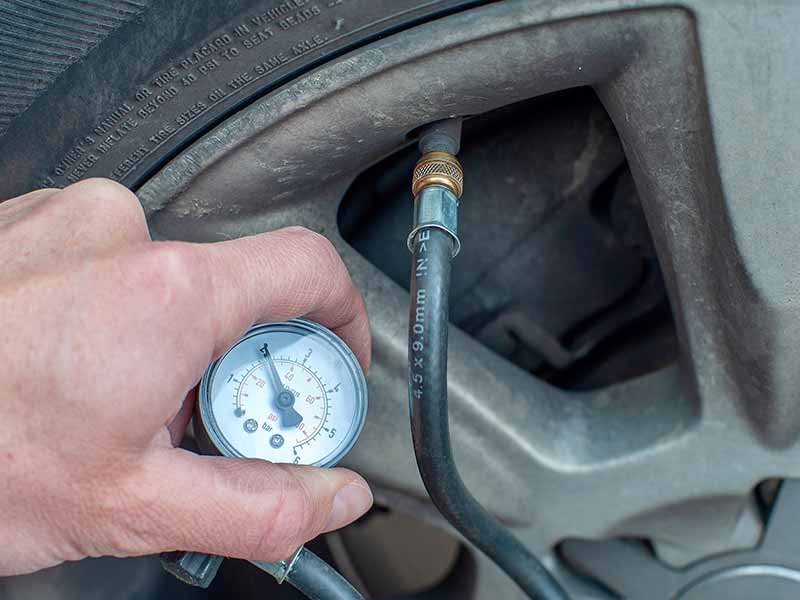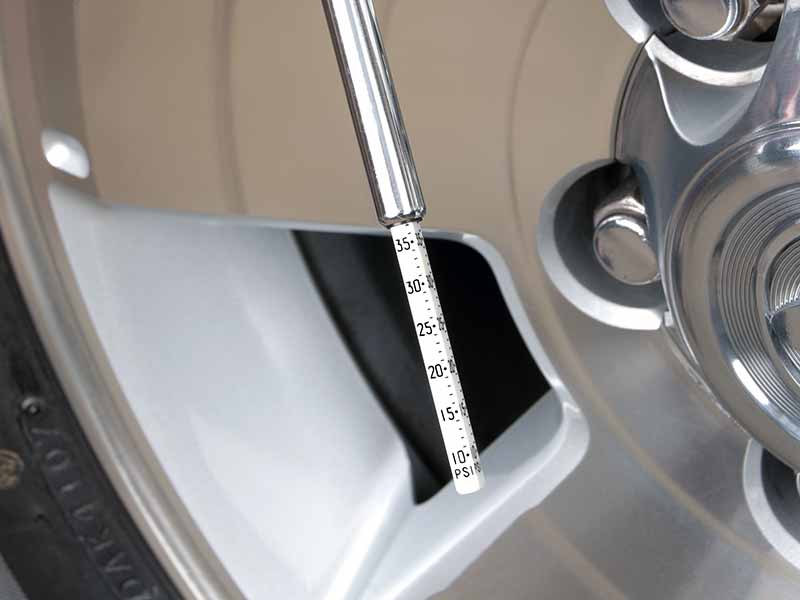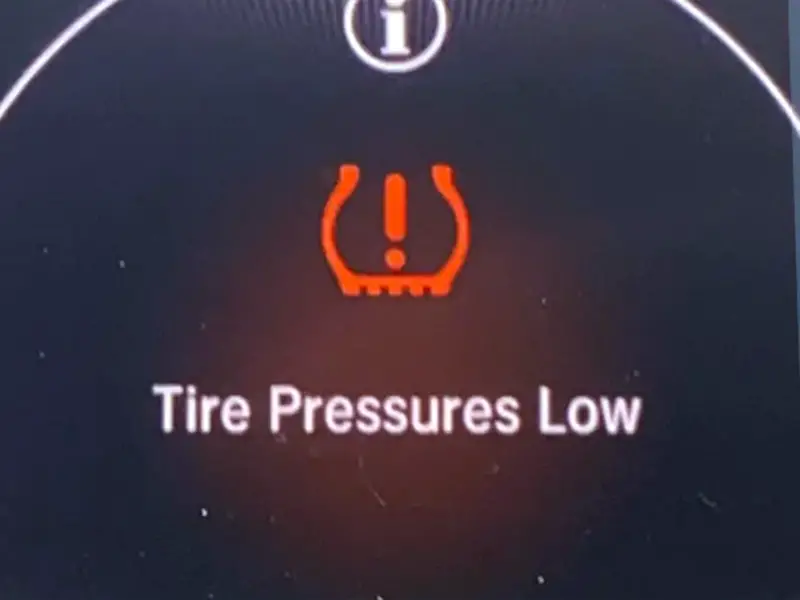Ever wondered why your car feels sluggish or why you’re burning through fuel faster than usual? The culprit could be right under your nose—or rather, under your car. Low tire pressure is not just a minor inconvenience; it’s a safety hazard that can cost you dearly.
What Tire Pressure Is Too Low?
Tire pressure below 20 PSI is extremely risky and could lead to a blowout. Generally, 25 PSI is considered too low for most passenger cars and trucks, affecting both vehicle performance and safety.
In this article, we’ll delve into what tire pressure is considered too low to drive on, the risks involved, and the immediate actions you should take. We’ll also discuss how to maintain proper tire pressure for optimal vehicle performance and safety.
Let’s take a closer look.

What Tire Pressure is Too Low to Drive On?
Determining what tire pressure is too low to drive on is crucial for your safety, the performance of your vehicle, and even your wallet. While the specific “too low” threshold can vary depending on the type of vehicle and its manufacturer’s recommendations, there are some general guidelines you can follow.
General Guidelines
- Below 20 PSI: Driving with tire pressure below 20 PSI is extremely risky and could cause a blowout.
- 25 PSI: Generally, 25 PSI is considered too low for most passenger cars and trucks. At this level, you’re at risk for tire damage and poor vehicle performance.
- 30 PSI: While better than 25 PSI, 30 PSI is still lower than the recommended levels for most vehicles. It may not be dangerously low, but it’s low enough to affect your car’s fuel economy and handling.
Front vs. Rear Tires
It’s worth noting that front tires often require higher pressure than rear tires, especially in front-wheel-drive vehicles. In some cases, rear tires could be as much as 5 PSI lower than the front tires. Always consult your owner’s manual for specific recommendations.

What is Considered Low Tire Pressure?
When we talk about tire pressure, we usually measure it in pounds per square inch, or PSI. But what numbers should you be looking for? Here’s how to understand what is considered low tire pressure:
- Recommended PSI: This is the tire pressure recommended by your vehicle’s manufacturer. You can find this information in your owner’s manual or on a sticker usually located on the driver’s side door jamb.
Common Low Tire Pressure Indicators
- Is 25 PSI Too Low?: Generally, 25 PSI is considered too low for most passenger cars and trucks. Driving with this level of pressure can put you at risk for tire damage and poor vehicle performance.
- Is 30 PSI Too Low?: While better than 25 PSI, 30 PSI is still lower than the recommended levels for most vehicles. It may not be dangerously low, but it’s low enough to affect your car’s fuel economy and handling.
Signs Your Tire Pressure is Too Low
- Warning Light: Most modern vehicles have a Tire Pressure Monitoring System that will alert you with a tire pressure warning light on your dashboard if your tire pressure is 25% or more lower than the vehicle manufacturer’s recommended air pressure.
- Handling Feels Off: If your car feels sluggish, or you’re having difficulty steering, this could be a sign of low pressure.
- Visual Checks: Sometimes, you can visibly see that a tire looks underinflated. It will appear flatter against the road compared to other tires.
Why Low Tire Pressure is a Problem
Safety Risks
- Reduced Grip: Low tire pressure can reduce the tire’s grip on the road, making steering and braking more challenging.
- Increased Risk of Blowouts: Driving with low tire pressure increases the risk of a sudden tire blowout, which can be dangerous, especially at high speeds.
Performance Issues
- Poor Handling: Your vehicle may not respond well to steering and may feel unstable, particularly when turning corners.
- Reduced Fuel Economy: Low tire pressure can make your engine work harder, reducing your vehicle’s fuel efficiency.
Long-term Damage
- Uneven Tire Wear: Tires with low pressure tend to wear out unevenly, which means you’ll need to replace them sooner than properly inflated tires.
- Increased Maintenance Costs: Over time, driving with low tire pressure can lead to other mechanical issues, increasing your maintenance costs.

What Does Low Tire Pressure Feel Like?
Low tire pressure doesn’t always trigger a warning light on your dashboard, especially in older vehicles that may not have a Tire Pressure Monitoring System. Therefore, it’s crucial to recognize the physical signs and symptoms that your vehicle may exhibit when tire pressure is low.
Handling and Steering
- Sluggish Response: One of the first things you’ll notice is that your vehicle doesn’t respond as quickly to your steering. It may feel sluggish or harder to control.
- Difficulty in Turns: You may find that your vehicle resists your attempts to make sharp turns or feels unstable during the turn.
Vibration and Noise
- Increased Vibration: Low tire pressure can cause your car to vibrate, especially when you’re driving at higher speeds.
- Unusual Noises: Listen for any unusual noises coming from the wheels, such as a thumping sound, which could indicate a severely underinflated tire.
Braking Issues
- Longer Stopping Distance: If your tire pressure is low, you may find that your vehicle takes longer to come to a complete stop when you apply the brakes.
- Reduced Brake Efficiency: The brakes may not feel as responsive as usual, requiring more force to slow down or stop the vehicle.

Risks of Too Low Tire Pressure
Driving with too low tire pressure is not just a minor inconvenience; it poses real risks to your safety, the performance of your vehicle, and even your wallet. Understanding these risks can help you appreciate the importance of maintaining proper tire pressure.
Safety Risks
Reduced Road Grip
- Loss of Traction: Underinflated tires have less contact with the road, reducing your vehicle’s grip. This can be particularly dangerous in wet or icy conditions.
- Impaired Steering: Low tire pressure can make steering more difficult, especially during emergency maneuvers.
Increased Risk of Blowouts
- Heat Buildup: Underinflated tires generate more heat, which can lead to a blowout, especially at high speeds.
- Structural Damage: Continuously driving on underinflated tires can weaken their internal structure, making them more susceptible to blowouts and punctures.
Performance Issues
Poor Handling
- Unstable Ride: Your vehicle may feel unstable, particularly when making turns or navigating through traffic.
- Reduced Braking Efficiency: Low tire pressure can increase your braking distance, making it harder to stop quickly in emergencies.
Lower Fuel Economy
- Reduced Mileage: Underinflated tires create more rolling resistance, making your engine work harder and reducing your miles per gallon (MPG).
- Higher Fuel Costs: Over time, the reduced fuel efficiency can add up, costing you more money at the gas pump.
Long-term Consequences
Uneven Tire Wear
- Premature Replacement: Tires with low pressure tend to wear out unevenly and more quickly, requiring more frequent replacements.
- Increased Maintenance Costs: Besides replacing tires, you may also face additional costs for alignment and suspension issues caused by driving with low tire pressure.
Environmental Impact
- Higher Emissions: Reduced fuel efficiency also means higher emissions, contributing to air pollution and climate change.

What to Do If Your Tire Pressure Is Too Low
If you discover that your tire pressure is too low, either through a warning light, a tire pressure gauge, or simply by the feel of the vehicle, immediate action is required. Here’s what to do:
Stop and Assess
- Find a Safe Spot: Pull over to a safe location, away from traffic, to check your tires.
- Visual Inspection: Look for obvious signs of underinflation, such as a tire appearing flatter than the others.
Check Tire Pressure
- Use a Tire Pressure Gauge: Measure the current pressure of all tires, not just the one that appears to be low.
- Compare with Recommended Levels: Refer to your owner’s manual or the sticker on the driver’s side door jamb for the recommended tire pressure for your vehicle.
How to Inflate Your Tires
Locate a Source of Air
- Gas Station: Many gas stations have air compressors you can use, often for a small fee.
- Portable Air Compressor: If you have a portable air compressor, you can use it to inflate your tires.
Inflate to Recommended Levels
- Attach Air Hose: Connect the air hose to the tire valve and begin inflating.
- Check Pressure Periodically: Use your tire pressure gauge to check the pressure as you inflate. Stop inflating once you reach the recommended level.
- Replace Valve Cap: Don’t forget to securely replace the valve cap after inflating each tire.

Understanding and Maintaining Proper Tire Pressure
Tire pressure, measured in pounds per square inch (PSI), is the amount of air in your vehicle’s tires. Maintaining the correct tire pressure is crucial for several reasons:
- Safety: Proper tire pressure ensures better grip on the road, reducing the risk of blowouts and improving steering and braking.
- Performance: Correct tire pressure enhances your vehicle’s handling and braking efficiency.
- Fuel Economy: Properly inflated tires can improve fuel efficiency by up to 3%, saving you money in the long run.
How to Check Your Tire Pressures
Checking your tire pressure is a straightforward process that requires a few essential tools:
- Tire Pressure Gauge: This tool measures the current pressure of your tires.
- Owner’s Manual: This provides the manufacturer’s recommended tire pressure for your specific vehicle.
It’s best to check the air pressure in your tires when they are cold, usually in the early morning or before long trips. Simply use the pressure gauge on each tire’s valve stem and compare the reading to the recommended levels in your owner’s manual.
Maintaining Proper Pressure In Your Tires
Regular maintenance is key to ensuring your tires stay at the optimal pressure:
- Monthly Checks: Aim to check your tire pressure at least once a month and before long journeys.
- Seasonal Adjustments: Be mindful of how air temperature affects tire pressure. Tires lose pressure in cold weather causing under-inflated tires, while hot weather can increase your tire’s air pressure.
- Tire Pressure Monitoring System (TPMS): Many modern vehicles have a TPMS that alerts you if your air pressure is 25% or more below the vehicle manufacturer’s recommended air pressure. However, this should not replace manual checks.
Resources
Below are some links you may find helpful when learning about tires
- How low is too low for tire pressure – J.D. Power
- What tire pressure is too low for safe driving – CarParts.com
Final Thoughts
Understanding and maintaining the correct tire pressure is more than just a routine check—it’s a crucial aspect of vehicle safety and performance.
Driving with low tire pressure can lead to a range of problems, from poor handling and increased fuel consumption to severe safety risks like blowouts. Therefore, it’s essential to regularly check your tire pressure and inflate them to the recommended levels.
Good luck and happy motoring.





